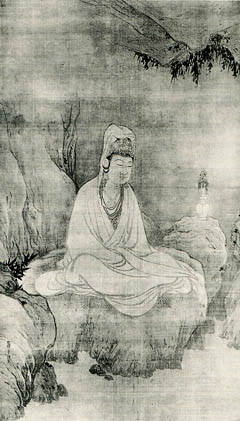Transition & Turmoil
Whenever a religion enters a new region dominated by an ethnic culture differing from that of its originating source, a certain amalgamation of ideologies, ethicalities, as well as prevailing myths and superstitions of the newly introduced religion and the antecedent religions takes place. Buddhism is an especially interesting case, as it has spread world wide and taken on many different flavors ...
A master serves several functions in a sangha: as a teacher and resource for practicing students, as a guide or "coach", as a leader or co-leader of ceremonies, as a disciplinarian, and often as an administrator. In addition, a master is usually responsible for the financial health of the temple, the spiritual health of the temple's constituency, maintaining a healthy public image in the ...
Many people equate Zen training with gong-an (koan) study due to the fairly frequent use of this teaching technique in Zen monasteries. Koans are one of many different techniques that teachers have used over the centuries to help students break through the rigid mental framework that obscures the higher domain of Self. In China, the use of the gong-an dropped as teachers began to recognize that ...
The context in which we view a thing has a great influence on our perception of it. It is a great influence on our perception of Zen.When we first learn about something it's with our senses and we know all too well that they can mislead, tricking us to believe that things are one way when they are, in fact, another. We enter a Buddhist temple and see a giant statue of the Buddha, smell the fine ...
While most of the world's great religions rely on the sanctity of words to convey the Truth of their religious doctrines, moral codes, etc., Zen Buddhism makes no such claim as it has no such written document or collection of documents. Instead, Zen Buddhism relies on the concept of Dharma Transmission to "preserve" the teachings of the Buddha. We conceive that the nature of Ultimate Reality is ...
Introductory Topics
Everyone who enters Zen's Gateless Gate, has a story to tell. Mine begins one summer evening when I received a call from a friend who had recently moved to another state. "I found a Buddhist Priest ...
If there is one word with which we can summarize the beauty of Buddhist thought, that word is Dharma. We cannot read a book about Buddhism without encountering this term, yet its definition is as ...
Suffering is integral to the Zen path. It is, in fact, a prerequisite. Zen is not an easy path and we must be highly motivated in order to travel it. In physics as in Zen, every action has an equal ...
We study the Sutras as a guide as we embark on our own spiritual adventures. They provide us strength in times of difficulties, give us solace in times of despair, and motivate us in times of apathy. ...
When we allow ourselves to move far away from the center, we experience the pain and bitterness that the Buddha described in his First Noble Truth. The cause of that distress, he said, is attachment. ...
In order to prepare ourselves for meditation, we must first begin to put our lives in order and act in accordance with what is right and good, both for us and for others. It is no simple task, for it ...
How do we begin with Zen? We don't start climbing Mt. Everest from the third base station. We start at the very bottom, climb a bit, set up camp, wait for a few days to let ourselves adjust to the ...
What is the nature of Self? In Chan, the answer is a spiritual one, dependent on self-reflection, and one that cannot come fully until we achieve a degree of spiritual awareness. In the secular ...
What is a "precept"? We Buddhists are all very aware of the five precepts (ore more or less depending on what school we associate with) we have taken when we chose to become Buddhists. But it seems ...
Consider our first multi-day meditation retreat. After a couple of days of discomfort, both physical and psychological, the rebellious ego begins to question the authority of the "strange Oriental ...
Chan mystics are the ultimate thrill-seekers. We're willing to risk everything to open doors to the unknown, to lift our heads out of the sand to glimpse the worlds beyond. And it all begins with ...
How do we keep our spiritual life alive? How do we keep moving forward? Embrace life in all its beauty and ugliness: treat all things with equanimity, seeing what is real and not what is superimposed ...
Consciousness. We don't think about it, we don't act upon it. It's just there. We awaken in the morning and go to the bathroom and do those things, make coffee, eat a donut, take the dog out … and ...
"If you see with the eye of truth, there is nothing mundane that is not true. If you look with the mundane eye, there is no truth that is not mundane." Fa Lian Shakya offers her art and poetry in ...





































